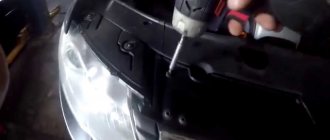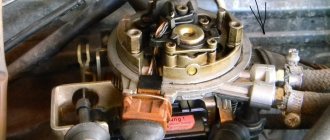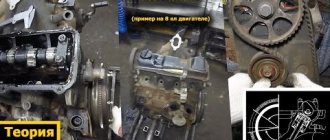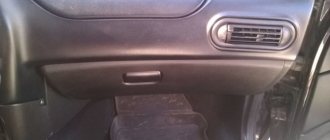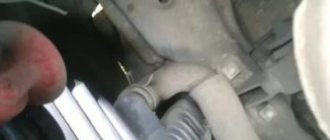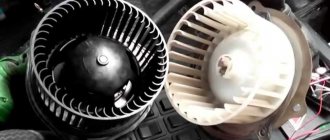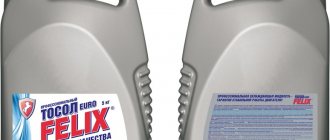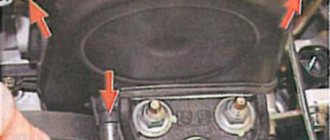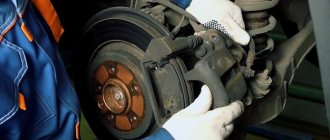04/23/2021 38,714 Volkswagen Passat
Author: Ivan Baranov
The car's cooling system is designed to maintain normal engine temperature by removing excess heat from heating engine parts. Antifreeze is used as a coolant in cars, which should be changed according to the instructions in the owner's manual. How to drain antifreeze from Volkswagen Passat B5, B3 and B6, as well as how to add new fluid, is described in the article.
While the engine is cold, the cooling system thermostat is closed, and antifreeze circulates in a small circle without entering the radiator. When the operating temperature reaches approximately 85 degrees, the thermostat opens slightly and fluid flows through the radiator. When the temperature reaches 105 degrees, which is determined using a temperature sensor, the thermostat opens completely and heated antifreeze enters the heating radiator, warming up the interior, and then returns to the pump.
You should constantly monitor the condition and level of coolant. The antifreeze level is visible through the transparent expansion tank; it should be between maximum and minimum. In a heated state, the level should correspond to the maximum, in a cold state - to the minimum. For the Volkswagen Passat cooling system, it is recommended to use blue-green antifreeze G 11. It creates a protective film against corrosion on components included in the cooling system. The film lasts for 2-3 years. You can fill in red antifreeze G 12, it is enough for the entire life of the car. You cannot mix two different antifreezes.
Antifreeze G11 green
Loading …
[Hide]
How to change coolant?
Changing the coolant must be done on a cold engine. Antifreeze is a toxic liquid, so you should be very careful when handling it. It is important to prevent liquid from coming into contact with skin, clothing, or paintwork. If this happens, the antifreeze must be washed off with plenty of water.
How to drain?
Before draining the coolant, first unscrew the cap on the expansion tank. In this case, safety precautions must be observed, since hot steam comes out of the tank. To avoid burns when unscrewing, you can cover the neck with a rag. The lid is slowly turned counterclockwise until a hissing sound is heard. When the pressure drops, unscrew the cap completely. If there is protection on the engine, it must be removed. In the area of the pump, under the car, a container is installed for the drained liquid.
If your car is equipped with power steering, first remove the drive belt from the pump pulley. Then lightly unscrew the bolts holding the pump bracket, then turn it upward so that the thermostat and cooling system pump hoses are accessible.
The lowest element of the cooling system is the pump. Three hoses are attached to it.
Three coolant hoses
The middle hose is too short, it is difficult to remove it without damaging it, so it is not touched. First, remove the clamps from the upper hose to disconnect it and drain the coolant. Then the lower hose going to the radiator is disconnected and the remaining antifreeze is drained. Remove the thermostat flange and the thermostat itself to drain the coolant from the cylinder block.
Thus, most of the liquid is drained from the system. Some of the liquid remains in the heating radiator. To get rid of it, remove the lower hose from the radiator, put on a hose of a suitable diameter and blow into it. Thus, the remaining antifreeze comes out of the radiator and the middle hose of the pump, which was not unscrewed.
Having finished washing, all hoses must be connected in the reverse order and the thermostat must be installed with a new rubber seal. When installing hoses on the pump, you should clean its outlets if there are deposits on them. If necessary, install a new temperature sensor for the Volkswagen Passat B3, two of them are needed.
The clamps must be installed in the same places. The power steering pump, along with the bracket and drive belt, is installed after new coolant has been added to the system.
If you neglected to replace the coolant, the cooling system will work ineffectively due to poor passage of channels clogged with sediment and rust. Therefore, it is advisable to flush the system before adding new fluid. For rinsing, use either clean or distilled water. The engine and radiator are flushed separately.
How to fill?
Before filling, you should prepare the coolant. To do this, antifreeze is diluted with clean or distilled water approximately 50/50. The antifreeze content should not be less than 40%! (MISSING)Before filling in coolant, it is necessary to check the integrity of the hose and the quality of tightening of the clamps. If everything is in order, the cooling system is filled with new coolant. Fill slowly to avoid any air bubbles. The liquid should be poured to a level just below the maximum.
Expansion tank in Volkswagen Passat
After the replacement is completed, it is necessary to check the tightness of the connection between the thermostat and the cooling pump, the hoses with the radiator and the pump. Places where antifreeze leaks are possible are identified by the presence of a white coating. The presence of cracks and the elasticity of the sleeves is checked by squeezing and bending them.
Then install the power steering pump and drive belt. Screw the cap on the expansion tank. After this, you should start the engine and let it run for some time in idle mode at accelerated speed. As soon as the temperature sensor gives a signal to the fan and it turns on, you should turn off the engine and check the coolant level in the tank. At operating temperature, the coolant level should be slightly below the maximum.
After turning off the fan, you should remove the air from the heating radiator. To do this, add speed to medium, in this mode the engine should run for two minutes. When the engine has cooled down, the level is checked again; it should not fall below the minimum. If everything is done correctly, the temperature sensor in operating mode will show a temperature of 80-90 degrees.
Cooling system "Passat B3"
The standard cooling system of the 1990 Volkswagen Passat B3 is controlled by a thermostat. At a sufficiently low temperature, antifreeze passes only in a small circle, washing the cylinder block. When 85-90 degrees are reached, the thermostat begins to open and the control unit starts a full circulation circle. The antifreeze will cool down thanks to the radiator grille.
Diesel engine cooling system. Photo source: https://manual.countryauto.ru/volkswagen/passat-b3-b4/4-1-obwie-svedenija.html
If the reading is above +92°, the fan is forced to turn on. As soon as the liquid temperature drops to +84°, ventilation will be turned off. The fan can turn on even without the ignition, since the engine needs to cool down after stopping.
Timing for replacing antifreeze in the Volkswagen Passat car system
It is necessary to regularly monitor the level and condition of the coolant. Thanks to the transparent expansion tank, you can see the antifreeze level; in normal condition it should be at a level between the minimum and maximum marks. If the antifreeze is in a cooled state, the level should correspond to the minimum value, and when heated, the level should correspond to the maximum.
For the cooling system located in a Volkswagen Passat, it is recommended to use G11 antifreeze, the color of which is blue-green. The presented antifreeze protects engine components and vehicle cooling systems by forming a protective film against corrosion. The validity period of the indicated film is two or three years. In addition, it is possible to fill in red antifreeze - G12, which is enough for the entire period of operation of the vehicle. It should also be noted that mixing two or more shades of antifreeze is prohibited.
It is important to know that when calculating the period for replacing antifreeze, experts recommend focusing not on years, but on mileage. Since during intensive use of the vehicle, antifreeze replacement may be required faster than indicated in the instructions for the coolant. If the owner of a Volkswagen Passat car has filled his car with G12 antifreeze, it is recommended to replace it after he has driven 250 thousand kilometers. If you use G11 standard coolant, replacement is necessary after reaching 150 thousand kilometers.
Signs by which the owner of a Volkswagen Passat can determine the need to replace the coolant:
- The vehicle's heater is not working well. If you notice that your car's heater is not functioning at the proper level, it is recommended to check the condition of the antifreeze;
- If a foam emulsion appears in the container in which the antifreeze is poured. The presented container is located in the engine compartment of a Volkswagen Passat. In a situation where the coolant loses the properties necessary for operation, it loses the ability to perform its basic functions, which will lead to a chemical reaction and the accumulation of foam in the system;
- Periodic heating of the Volkswagen Passat engine. In a situation where antifreeze cannot cool the car engine, it will begin to overheat. In this case, it is imperative to replace the coolant;
- If sediment has formed in the reservoir, in the engine compartment of the Volkswagen Passat. If physical properties are lost, a chemical reaction occurs, resulting in the formation of a precipitate.
In addition, it should be noted that it is prohibited to reuse antifreeze if the radiator, heater or cylinder head of a Volkswagen Passat is being repaired.
Replacement timing and choice of coolant
During production, liquids of standard G12 must be filled into the radiator device of the cooling system. The service life of such refrigerants is about 250 thousand kilometers or five years, whichever comes first. This applies to the initial replacement of consumables. If you use a different class of antifreeze, which is highly not recommended for the cooling systems of Volkswagen Passat cars, then the timing of replacing the fluid will be different. On average, G11 antifreezes retain their properties for three years or 100-150 thousand km.
The following symptoms may indicate that you need to replace and add new refrigerant:
- Poor stove operation. If you feel that the stove has begun to function less efficiently, you need to check the condition of the working substance.
- A foam emulsion has appeared in the antifreeze container located in the engine compartment. When a liquid loses its properties, it will not be able to perform its functions. As a result of chemical reactions, foam will begin to appear in the system.
- The car engine periodically overheats. If the coolant cannot cool the power unit, it will cause it to overheat. The fluid needs to be changed.
- Formation of sediment in a container in the engine compartment. When physical properties are lost, a chemical reaction occurs, as a result of which a precipitate appears in the system. They can clog its highways.
How to change antifreeze?
Below we will look at how to change the consumables in the cooling system of a Volkswagen Passat with your own hands.
What will be required for replacement?
To complete the task you will need the following:
- fresh antifreeze in the amount of six liters;
- container into which old antifreeze from the car will be drained;
- set of wrenches;
- rags.
User KOSTACITY10 made a video where, using a photo, he showed how to drain the Passat B3 antifreeze yourself.
How to drain?
To make the change, antifreeze or antifreeze must be drained from the cylinder block:
- First, drive the car into a garage with a pit; you can also use an overpass. The change procedure is performed on a cold engine.
- Find the refrigerant fill reservoir and remove the cap from the container. If the power unit is hot, hot steam will come out of the tank after unscrewing. Therefore, it is better to cover the lid with a cloth.
- Get under the bottom of the vehicle. If the power unit of the machine is equipped with protection, it must be removed. To do this, unscrew the bolts securing it.
- Coolant will drain from the pump; place a container under it. If the machine is equipped with power steering, then to complete the task you will need to remove the drive belt from the shaft of the pumping device. After this, remove the screws that secure the pump bracket. Turn the device itself to the upper side, this will allow you to gain access to its pipes, as well as the lines connected to the thermostat.
- The pump is the lowest component of the cooling system; three pipes are connected to it. The middle line is too short, it is difficult to disconnect it without damaging it, we will not touch this hose. Loosen the screws on the clamps and remove them from the upper line. This will allow you to disconnect the hose and drain the refrigerant. Then the clamp is loosened and the lower line connected to the cooling radiator is unscrewed. The old refrigerant is drained. The thermostat flange and the device itself are dismantled, this will allow more fluid to drain.
- But these steps will not allow you to completely drain the antifreeze, since some of the substance will remain in the radiator device. To remove it, the lower pipe from the radiator is disconnected, a hose of the appropriate size is installed instead, after which it is necessary to blow into its other end. This will remove the remaining coolant from the radiator unit and the pump middle line, which we did not disconnect.
How to flush the system?
To perform flushing, do the following:
- Pour distilled water or a special cleaning agent into the cooling system. Bring the refrigerant level to normal.
- All pipes and covers, both drain and filler, must be closed.
- Start your car engine. Perform a test ride.
- Drain the distillate or flushing antifreeze from the system by repeating the above procedure. If the liquid is too dirty, the washing procedure must be performed again. The lines are cleaned until the refrigerant leaving the system is completely clean.
- After finishing the flushing, all pipes are connected in place in the reverse order. The thermostat is being installed; if its rubber seal is worn out, it must be replaced. When connecting the pipes to the pump, the lines are cleared of deposits, if any. If the refrigerant temperature controller has failed, it must also be replaced. Place the clamps in the same places. Installation of the power steering pump unit with bracket and drive belt is carried out after the refrigerant is filled, so there is no need to touch these elements yet.
Filling the flushing agent into the Passat expansion tank Draining the flushing agent from the cooling system
How to fill?
Filling the refrigerant is done as follows:
- If you use a concentrated liquid, then it must be diluted with distillate in the proportion indicated on the package label. Usually this is 1:1, but keep in mind that the refrigerant itself in the system must be at least 40%! (MISSING) Before filling, make sure that all pipes and lines are intact, as well as the quality of tension of the clamps.
- The consumables are filled through the neck of the expansion tank. The liquid must be added slowly so that an air lock does not form in the system. Fill the refrigerant to almost the maximum level.
- Make sure there are tightness at the connections between the thermostat and the cooling system pumping device, the radiator and the pump. There is usually a white coating at the leak site. If you notice damaged lines, they need to be replaced.
- Screw the cap onto the reservoir in the engine compartment. Start the power unit and let it run at high idle speed for several minutes.
- When the engine warms up, the engine temperature controller will send a signal to the ventilation device. It is activated, after which the internal combustion engine can be stopped. Check the refrigerant level in the tank again. On a warm engine, the fluid volume should be less than the maximum, but higher than the average mark.
- Start the engine again, now it should run at medium speed, this will get rid of a possible air lock in the radiator device.
- Turn off the engine and wait until it cools down. Check the refrigerant volume, it must be at least the minimum level. If all steps are performed correctly, the temperature controller will show about 80-90 degrees.
Passat b3 dashboard repair
Or maybe this: How to check the coolant temperature gauge? On some models there may be...
If you suspect that the temperature gauge is not working, check it as follows.
The sensor is located in the cylinder head behind the water pump on 1.2L engines, in the intake manifold on 1.3 and 1.4L engines and in the thermostat housing on 1.6, 1.8 and 2.0L engines. Partially drain the coolant from the cooling system below the sensor installation level, or have a suitable plug that must be used to close the hole after unscrewing the sensor. AnatolL Admiral B3
This must be done extremely carefully so as not to damage the heating element wire wound on the plastic.
As a result, both gasoline and coolant plates should look exactly the same in appearance. We assemble the device in reverse order.
To check the functionality, connect a 4.5-volt battery from a flashlight, first to a pair of coolant contacts - the needle should slowly deviate by half the scale, then to a pair of gasoline - the effect should be similar. You can use a 9 volt battery, then the arrows should deflect almost to the maximum values.
Coolant temperature sensor (CTS). Examination
Passat B3 1993 Cooling temperature sensor shows more than 110
Intermediate variants of this malfunction are possible when, with serviceable sensors, after replacing them, instrument readings are underestimated, which can also be due to bending of the bimetallic plates.
AnatolL Admiral B3 Before removing the dashboard, do the following: Remove the connector from the G2 pointer sensor.
If the gauge arrow shows low engine temperature, disconnect the electrical connector from the temperature sensor and connect it to ground.
If the indicator arrow deviates when the ignition is on, it means that the temperature sensor is faulty and needs to be replaced. If the pointer needle does not move, remove the instrument cluster and check the electrical circuit between the sensor and the pointer, as well as the voltage supply to the pointer.
If the electrical circuit is normal, then the temperature gauge is faulty and needs to be replaced. If the temperature gauge shows a high temperature all the time, disconnect the electrical connector from the sensor.
Recommended Posts
Disconnect the electrical connector from the sensor and unscrew the sensor. Before screwing in the sensor, apply a thin layer of sealant to the sensor threads.
Screw the sensor into place and connect the electrical connector to it. Pour coolant into the cooling system.
Replacing the thermostat
When replacing the thermostat, you must perform the following steps.
- The two mounting bolts are unscrewed.
- The special plastic flange is removed.
- The old thermostat is removed.
The thermostat replacement process is quite simple. - A new thermostat is being installed.
- A special rubber O-ring is installed.
- The plastic flange returns to its place.
The flange holds the thermostat in the housing
Video: replacing the thermostat
Removing and installing cooling system elements
The principle of operation of the cooling system is the same, but the implementation of the process in different modifications of the Passat may differ. For example, in an 8-valve engine, the supply to the tank is on the left, and an internal combustion engine with 16 valves is on the right. There may also be a different fan drive, based on an electric motor or viscous coupling.
Despite the fact that the location of the parts may differ, the order of execution is the same:
When disassembling, the main thing is to know the principle and sequence of operation. Installation of all parts is carried out in reverse order. If extra ones appear, it is better to repeat the procedure or contact a car service.
Source
Replacing coolant in Volkswagen Passat B5
Coolant - what to do with it? And so, according to the official dealer, the coolant is filled for the “entire” service life of the car. Replacing Volkswagen Passat coolant After all, none of us have been frying potatoes in the same oil for 5 years, for example. And we are all not stupid people and we understand that any technological fluid comes to an end and it ceases to perform its functions either completely or partially. Got busy with the issue.
How to drain antifreeze from an engine. On B5 there was a tap on the lower left side near the radiator. On B7 there is just a hose with a clamp. To get to the clamp. You need to remove the left and right intercooler pipes by unscrewing the clamps with a flat screwdriver.
Replacing Coolant Passat B3
If you neglected to replace the coolant, the cooling system will work ineffectively due to poor passage of channels clogged with sediment and rust. Therefore, it is advisable to flush the system before adding new fluid. For rinsing, use either clean or distilled water. The engine and radiator are flushed separately.
How to fill?
Before filling, you should prepare the coolant. Before filling in the coolant, it is necessary to check the integrity of the hose and the tightening of the clamps. If everything is in order, the cooling system is filled with new coolant. Fill slowly to avoid any air bubbles. The liquid should be poured to a level just below the maximum. Expansion tank in the Volkswagen Passat After the replacement is completed, it is necessary to check the tightness of the connection between the thermostat and the cooling pump, the hoses with the radiator and the pump.
Places where antifreeze leaks are possible are identified by the presence of a white coating. The presence of cracks and the elasticity of the sleeves is checked by squeezing and bending them. Then install the power steering pump and drive belt.
Screw on the coolant cap on the expansion tank. After this, you should start the engine and let it run for some time in idle mode at accelerated speed. As soon as the temperature sensor gives a signal to the fan and it turns on, you should turn off the engine and check the coolant level in the tank. Move the heating system temperature regulator to the maximum temperature position.
Loosen the clamp securing the fluid return hose from the heater radiator. Move the hose from the fitting as much as possible so that the fitting does not cover the hole in the hose to remove air. To remove air, unscrew the two plugs that are located on the cooling system pipes next to the expansion tank. Screw in a threaded adapter with a tube with a diameter of 42 mm and a height of mm with the cover.
This is necessary to completely fill the cooling system with liquid and displace air from there. Fill the liquid into the Volkswagen Passat coolant reservoir until the coolant flows out through the screw plugs to remove air.
The plugs must be screwed in with a force of 20 N.
Fill the coolant into the cooling system until it begins to flow out through the hole in the hose.
Push the hose onto the fitting as far as it will go and secure it with clamps. Lower the revs to idle and wait until the car warms up. Turn off the engine. Check the coolant level. If necessary, top up. When the engine is warm, the coolant should be at the MAX level.
When the engine has cooled down between MIN and You can also change the coolant in a garage. To do this, you just need to acquire the necessary tools and have a little experience.
The entire replacement procedure takes no more than hours.
Causes of coolant leaks and how to fix them
The most common breakdown of the cooling system of a Volkswagen Passat vehicle is an antifreeze leak. With the help of the presented liquid, the engine does not overheat and operates properly. In addition, antifreeze allows you to save on fuel.
The Volkswagen Passat engine performs its functions most productively in a certain temperature range. If the engine temperature begins to exceed permissible values, the car owner will be able to observe the following signs:
- Steam is coming out from under the hood of the vehicle;
- White smoke is visible from the car muffler;
- The heater in the cabin cools the air rather than heating it;
- A warning about engine overheating flashed on the dashboard;
- The thermometer needle has reached its maximum value.
It should be noted that the appearance of one or several signs is possible. But in any case, if any of the above signs appear, you should turn off the engine of the Volkswagen Passat vehicle and find the cause of the antifreeze leak.
The reasons for a coolant leak from the Volkswagen Passat system may be as follows:
- To begin with, it should be noted that in the cold season, antifreeze tends to decrease in volume. Based on the information presented, in winter it is necessary to replenish refrigerant reserves more often;
- Coolant may leak through cracks or gaps in the cap or reservoir. The problem presented is difficult to detect. This is due to the fact that the defects are almost invisible and rather resemble scratches. Based on the information provided, it is recommended to contact specialists to solve this problem;
- The problem may also be damage to hoses, tubes or depressurization of connections. In addition to these parts, the thermostat gasket may also leak;
- Another reason for an antifreeze leak may be a broken heating radiator;
- In addition, coolant may disappear due to contact with the engine oil.
So, we can summarize. If antifreeze leaks from the system of a Volkswagen Passat, you should check the cap and reservoir for cracks. In addition, it is necessary to check the cooling system pipes and their connections. If you cannot solve the problem yourself, it is recommended to seek help from a specialist.
How to properly replace antifreeze in a Volkswagen Passat?
Before you begin the procedure for replacing antifreeze in a Volkswagen Passat, you must purchase the following tools:
- Six liters of new antifreeze;
- A container into which the old coolant will be drained;
- Set of wrenches;
- Rags.
When purchasing antifreeze, you need to focus on the year in which the Volkswagen Passat was produced.
In this case, the following recommendations should be highlighted:
- If the vehicle was manufactured between 1991 and 1997 inclusive, then only green antifreeze of the G11 standard should be poured into the cooling system, which must be replaced once every three years. The best brands of the designated coolant are Zerex G, Glysantin G 48, Aral Extra, as well as others;
- Volkswagen Passat, which was released from the assembly line between 1998 and 2002, must be filled with G12 class antifreeze. The best options in this case are the following coolants - Castrol SF, Motorcraft, AWM, GlasElf;
- If the car was produced between 2003 and 2009, then it is recommended to fill the cooling system with red G12+ antifreeze. The best options in this case are Lukoil Ultra, G-Energy, Havoline, Chevron;
- Volkswagen Passat, which was produced after 2010, must be filled with red antifreeze class G12++. A special feature of the presented coolant is its durability (up to 7 years) and rich composition. Suitable products in the indicated situation are FEBI, VAG, MOTUL, DSC, Freecor.
According to the recommendations of Volkswagen Passat manufacturers, the coolant should be replaced after performing any actions that require draining the antifreeze. It should also be noted that the recommendations presented apply to other Volkswagen models, such as Jetta and Vento.
Step-by-step instructions for draining and flushing the Volkswagen Passat system
Before you start replacing antifreeze, you first need to drain it from the cylinder block. To do this, you need to adhere to a certain algorithm, which will be presented below.
The procedure for draining coolant in a Volkswagen Passat car:
- First you need to drive the vehicle into a garage with a pit or use an overpass. It should be noted that the process of replacing antifreeze must be carried out with a cold Volkswagen Passat engine;
- Next, you need to find a reservoir for filling the coolant, and then remove the lid from the container. In a situation where the power unit is heated, hot steam should come out of the tank after unscrewing. Based on the information provided, when performing these steps, it is recommended to cover the lid with a cloth;
- The next step is to climb under the bottom of the Volkswagen Passat. If the power unit is equipped with special protection, it must be dismantled. To do this, you will need to unscrew the bolts that secure it;
- Next, the antifreeze is drained from the pump into a container that must be placed under it. If the vehicle, namely the Volkswagen Passat, is equipped with power steering, then to carry out the presented task, the drive belt must be removed from the pump mechanism shaft. Then you need to unscrew the screws securing the pump bracket. In turn, the device must be turned to the upper side. The presented action will allow you to gain access to its pipes and lines that are connected to the thermostat;
- The pump is the lowest component of the cooling system, to which three pipes are connected. Since the middle line is too short, it is not recommended to touch it. This is done due to the fact that it is difficult to detach without damage. Instead, it is necessary to loosen the bolts on the clamps and remove them from the upper line. The presented action will allow you to turn off the pipe and drain the antifreeze. Next, you will need to loosen the clamp and unscrew the lower line, which is connected to the car’s cooling radiator. After the above steps have been completed, the old coolant is drained. To drain more antifreeze, remove the thermostat flange and the device itself;
- However, the steps above will not completely drain the coolant. This is due to the fact that part of the antifreeze remains in the radiator device. To remove the remaining liquid, disconnect the lower hose from the radiator and install a hose of the appropriate size in its place. After the hose is installed, you need to blow into its other end. This action allows you to remove the remaining antifreeze from the radiator unit, as well as from the middle line of the pump, which has not been disconnected.
After the refrigerant has been drained, it is necessary to thoroughly flush the entire cooling system of the Volkswagen Passat.
To perform flushing, do the following:
- First, you should pour distilled water into the cooling system. In addition, you can use a special cleaning agent. Then the coolant level should be brought to normal;
- All pipes, as well as covers, such as filler and drain, must be tightly closed;
- At the next stage, you need to start the engine of the Volkswagen Passat vehicle, and then perform a test drive;
- Next, you need to drain the distillate or flushing coolant from the cooling system by repeating the above process. If the drained liquid is too dirty, the flushing process must be repeated. Cleaning the lines should be carried out until the antifreeze that is drained from the system is completely clean;
Draining flushing agent from the cooling system - After flushing the cooling system has been completed, you need to connect all the pipes in place. The indicated action is performed in reverse order. Next, the thermostat is installed. In a situation where its sealing rubber is unsuitable for further use, it needs to be replaced. In the process of connecting the pipes to the main pump, it is necessary to clear them of deposits, if any. If the coolant temperature controller is faulty, it should also be replaced with a new one. The clamps must be secured to the same places. Installation of the drive belt and bracket with the power steering pump device is carried out after new antifreeze has been poured. Based on this, the presented elements should not be touched for now.
Pouring new refrigerant into the Volkswagen Passat car system
Expansion tank in Volkswagen Passat
Filling new coolant into the Volkswagen Passat car system is carried out as follows:
- If the owner of a Volkswagen Passat uses concentrated antifreeze, then it should be diluted with distillate. The proportions according to which it is necessary to dilute the presented liquids are indicated on the packaging label. Often this is 1 to 1, but it should be noted that the antifreeze itself in the system must be at least 40%! (MISSING)Before pouring the finished mixture, you need to make sure that all pipes and lines are intact. In addition, you need to check how well the clamps are tightened;
- A mixture of coolant and distillate is poured into the neck of the expansion tank. The resulting material must be added slowly. This is done to prevent an air lock from forming in the cooling system. Antifreeze is poured almost to the maximum level;
- Next, you need to make sure that the connections between the thermostat and the radiator, with the pumping device of the cooling system and the pump are sealed. Often, a white coating forms in places where there are leaks. It should also be noted that if damage to the main line is detected, it must be repaired;
- The next step is to tightly tighten the plug on the reservoir in the engine compartment. Then you should start the engine of the Volkswagen Passat and let it run at high idle speed for a couple of minutes;
- Once the vehicle's engine has warmed up, the engine temperature controller will signal the ventilated device, causing it to activate. After this, you can turn off the engine of the Volkswagen Passat. Next, you need to check the coolant level in the container again. When the engine is warm, the volume of antifreeze should be slightly less than the maximum, but above the average mark;
- The next step requires starting the Volkswagen Passat engine again. However, now he should work at medium speeds. The presented action will allow you to get rid of the air lock in the radiator device, if there is one;
- Finally, you need to turn off the engine of the Volkswagen Passat and wait until it cools down. After the temperature drops, it is necessary to check the volume of coolant; it should not be less than the minimum mark. If all the above steps were performed correctly, the temperature controller will show 80-90 degrees Celsius.
VW Passat B3 repair
G-011-V8C is used as a coolant .
TOSOL can be used as an emergency substitute, but it’s still better to just fill it with clean water in order to get to your destination and fill it with G 11 antifreeze, I even think it will be better, since the engine cooling system will be washed and all that remains is to drain the water and fill it with antifreeze.
Antifreeze G11 (blue-green) creates a film on the surface of the cooling system parts that protects against corrosion. The durability of G11 film and its analogues is approximately 2 – 3 years.
G11 is not recommended to be mixed with G 12 and G 12+ (red) antifreeze. G 12 and G 12+ have advantages only from an environmental point of view and it is believed that these antifreezes are filled in for their entire service life.
I don’t recommend pouring antifreeze, because it washes out the lubricant of the pump bearing and corrodes aluminum, and not only, engine parts. How many people were forced to change the cylinder heads because of antifreeze, now there is no real antifreeze anymore.
So, in order to change the coolant in the Volkswagen Passat B3 engine cooling system, you need:
- open the lid on the RB
- remove the engine protection (if installed)
- place a container under the engine (in the area of the pump)
- remove the thermostat flange and the thermostat itself (you can first remove the hose from the thermostat flange and drain some coolant from the cooling system, but then you still need to remove the thermostat)
After the coolant has completely drained, I recommend pouring clean water (ideally distilled), starting the engine (without a thermostat) for 10-15 minutes, draining the dirty water (ideally repeat this procedure several times), pouring ready-made, diluted antifreeze . You can add concentrate and then distilled water.
The engine cooling system of the Volkswagen Passat B3 includes an average of 6.3 liters. up to 7 l. antifreeze.
After you have carefully poured coolant into the cooling system, you need to start the engine and knead the hoses going to the radiator with your hands (in this case, you need to monitor the coolant level in the coolant and top up if necessary).
We wait until the fan on the radiator turns on, after which you need to expel the air from the heating radiator (stove).
To do this, you can simply increase the engine speed to medium or higher and hold it for a couple of minutes; many recommend throttling the engine on a slope, that is, drive the front of the car up some kind of slope and apply the gas for a couple of minutes.
If you have any additions, questions or comments, do not hesitate to write, I will be happy to answer.
Flange replacement
The flange is made of plastic. Therefore, over time and under the influence of temperature changes, it fails. Cracks and delaminations appear on the flange body, and a small coolant leak occurs. If the flange is not replaced in a timely manner, the engine may overheat due to a lack of coolant with all the ensuing consequences.
Despite the low cost, the importance of the flange for high-quality engine cooling is quite high. Therefore, it is recommended to purchase only new high-quality flanges.
The flange plays a significant role in high-quality engine cooling
On sale you can find flanges both complete with a ring-shaped rubber gasket and without it. It is recommended to purchase the following products:
- flange for coolant temperature sensor with return outlet (VAG No037121132E);
- flange for coolant temperature sensor without return outlet (VAG No037121132B);
- right side flange for heater (VAG No026121144E);
- O-ring (VAG No037121687).
Replacing the flange is easy to do yourself. The following tools will be required:
- socket wrench 10;
- sliding pliers for removing the original tightening clamps;
- screwdriver;
- wrenches 6 and 8 (when using conventional clamps on pipes);
- file;
- sealant;
- coolant container with a volume of at least two liters;
- rubber hose for draining coolant from the expansion tank.
The flange replacement process is as follows:
- The cover of the expansion tank is opened, and the coolant is drained into a pre-prepared container using a hose.
- The lower pipe is disconnected from the expansion tank and the coolant is drained.
- The hoses are disconnected.
- If necessary, disconnect the electrical wiring leading to the temperature sensor (when replacing the front flange).
- Other parts that prevent the removal of the flange are dismantled (when replacing the right heater flange).
- The flange mounting bolts are unscrewed.
- The flange is removed.
- The old studs are removed.
- The seat is cleaned with a file and sandpaper. Then this area is degreased.
- If the old studs fail, new ones are installed.
- A layer of sealant is applied to the seating surface of the new flange.
The new cooling system flange is installed on the sealant - The new flange is pressed onto the studs.
- The nuts are tightened with a little effort.
- If the expansion tank is dirty, it is washed with water under pressure.
- The pipes are installed in their places.
- A temperature sensor (front flange) is installed through a sealing ring.
- Electrical wiring is connected.
- Coolant is poured into the expansion tank.
- The car engine starts.
- As when replacing a pump, the tightness of the connections is checked and air pockets are removed.
Consequences of untimely replacement
To prevent failure of cooling system elements and their repair, it is necessary to change antifreeze in a timely manner. If the refrigerant is changed at the wrong time, this will lead to the fact that the consumable will not be able to effectively cool the power unit of the machine. As a result, the engine will be susceptible to overheating, and regular use of the vehicle in such conditions can lead to rapid wear of the power unit and its failure.
When using refrigerant that has exhausted its service life, the liquid quickly loses its working properties. As a result, emulsion in the form of deposits will begin to accumulate in the system, and foam will appear. The presence of sediment in the lines will lead to an increase in pressure in the channels. As a result, under its influence, oil seals and sealing elements will begin to be squeezed out, which will lead to leakage of consumables.
Coolant circulation diagram Volkswagen Passat B3
how to remove an air lock
Engine cooling system. Design and principle of operation
Engine VW Passat B3 Engine VW Passat B3
How to bleed air from the Audi 80 cooling system. [@2015]
Chery Amulet. About the cooling system or how to avoid engine overheating
Replacing the pump and thermostat for VW, Audi, Skoda, Seat, choice of antifreeze, tolerances, review
Gases and boiling of antifreeze. Engine 1.9 TD AAZ | Gases and boiling antifreeze. Engine 1.9 TD AAZ
There is no return flow in the expansion tank of VW Passat
The stove doesn't heat well. What to do? Volkswagen Passat B3 - B4
Flushing the stove and installing an additional pump through a reed switch into the cooling system.
Also see:
- Volvo XC90 window control unit
- The first thing is on Lexus is 250
- Mercedes Benz sprinter van dhl with bruder loader 02 534
- BMW E46 rear arch repair kit
- Honda Accord 2012 top speed
- Kia cerato 2015 operating instructions
- Opel Corsa rumbles like a tractor
- Chevrolet Niva on wide wheels
- PTF lamp base Ford Focus 2 restyling
- How to remove the heater valve of a BMW E39
- New fourth generation Opel Zafira
- What kind of battery is installed on Kia Rio
- Mitsubishi Pajero 1999 left hand drive
- Ford Focus 2 diesel repair
- Footrests for Kia Sportage 3 style BMW
Home » New » Coolant circulation diagram Volkswagen Passat B3
logovaz-auto.ru
Engine cooling system Volkswagen Passat b3 diagram photo
Engine cooling VW Passat B3
Known for its reliability, the Volkswagen Passat B3 is a car that has earned the recognition of many drivers. The simplicity of the design and durability of the components allow this car to remain on the move even after many years of operation. This is only possible if repairs and maintenance are carried out in a timely manner. So, maintaining cooling performance is a very important factor. The diagrams and photos of the Volkswagen Passat B3 engine cooling system presented in the article will help you understand this issue.
General information
The purpose of the Passat B3 engine cooling system is to maintain the operating temperature of the engine by cooling its parts that are prone to heating and dissipating heat to the surrounding space. Among the components of the Volkswagen Passat b3 cooling system are the following:
- antifreeze pump
- a radiator that transfers heat to the atmosphere.
- expansion tank that compensates for the thermal expansion of the liquid.
- a fan that supplies atmospheric air to the radiator.
- a thermostat that regulates the movement of antifreeze in a large and small circle depending on the temperature.
- hoses connecting the above elements of the overheating prevention circuit.
When the antifreeze temperature reaches 85 °C, all the heat is spent on warming up the engine. In the temperature range from 85 to 105 °C, the thermostat partially opens and heated antifreeze is supplied to the radiator. When heating above 105 °C, the thermostat opens completely and all the coolant is diverted to the radiator.
Basic principles of service
To safely service your cooling system, it is important to exercise some caution. So, opening the expansion tank in a still hot system can cause burns from the hot vapors escaping. It is also not recommended to completely turn off the engine after prolonged use in order to avoid boiling of the liquid that does not circulate through the system due to the pump stopping. This can cause serious damage to the entire cooling system.
If problems are detected, the first thing you need to do is check the antifreeze level, pump belt tension and serviceability of the temperature sensor. Slow warming up of the engine may indicate a thermostat failure, which consists of it being stuck in the open position. In this case, the radiator will heat up immediately after starting the engine. If the radiator remains cold when the temperature sensor readings are above 85°C, the thermostat is likely stuck closed. Both of these cases indicate the need to replace the thermostat.
Cooling system diagrams Passat b3
SOHC engine cooling system
1 – radiator; 2 – thermostat; 3 – connecting pipe; 4 – expansion tank; 5 – top cover; 6 – air intake; 7 – fan bracket; 8 – fan bracket; 9 – fan bracket; 10 – additional fan; 11 – drive belt; 12 – electric fan.
DOHC engine cooling system
1 – radiator; 2 – pump; 3 – thermostat; 4 – expansion tank; 5 – oil heat exchanger; 6 – back cover; 7 – fan bracket; 8 – fan bracket; 9 – electric fan; 10 – additional fan; 11 – drive belt; 12 – top cover; 13 – air intake.
Diesel engine cooling system
1 – radiator; 2 – coolant pump; 3 – thermostat; 4 – oil radiator; 5 – electric pump; 6 – expansion tank; 7 – turbocharger hose; 8 – cover; 9 – bracket; 10 – electric radiator fan; 11 – additional radiator fan; 12 – belt; 13 – casing.
Video: Design and principle of operation of the engine cooling system
vwservice1.com
